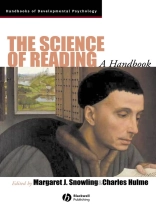The Science of Reading: A Handbook brings together
state-of-the-art reviews of reading research from leading names in
the field, to create a highly authoritative, multidisciplinary
overview of contemporary knowledge about reading and related
skills.
* * Provides comprehensive coverage of the subject, including
theoretical approaches, reading processes, stage models of reading,
cross-linguistic studies of reading, reading difficulties, the
biology of reading, and reading instruction
* Divided into seven sections:Word Recognition Processes in
Reading; Learning to Read and Spell; Reading Comprehension; Reading
in Different Languages; Disorders of Reading and Spelling;
Biological Bases of Reading; Teaching Reading
* Edited by well-respected senior figures in the field
state-of-the-art reviews of reading research from leading names in
the field, to create a highly authoritative, multidisciplinary
overview of contemporary knowledge about reading and related
skills.
* * Provides comprehensive coverage of the subject, including
theoretical approaches, reading processes, stage models of reading,
cross-linguistic studies of reading, reading difficulties, the
biology of reading, and reading instruction
* Divided into seven sections:Word Recognition Processes in
Reading; Learning to Read and Spell; Reading Comprehension; Reading
in Different Languages; Disorders of Reading and Spelling;
Biological Bases of Reading; Teaching Reading
* Edited by well-respected senior figures in the field
Inhaltsverzeichnis
List of Contributors.Preface.
Acknowledgments.
Part I: Word Recognition Processes in Reading:.
Editorial Part I.
1. Modelling Reading: The Dual-Route Approach: Max Coltheart (Macquarie University, Australia).
2. Connectionist Approaches to Reading: David C. Plaut (Carnegie Mellon University).
3. Visual Word Recognition: Theories and Findings: Stephen J. Lupker (University of Western Ontario).
4. The Question of Phonology and Reading: Guy C. Van Orden and Heidi Kloos (Arizona State University).
5. Eye Movements During Reading: Keith Rayner, Barbara J. Juhasz, and Alexander Pollatsek (University of Massachusetts).
Part II: Learning to Read and Spell:.
Editorial Part II.
6. Theories of Learning to Read: Brian Byrne (University of New England, Australia).
7. Writing Systems and Spelling Development: Rebecca Treiman and Brett Kessler (Washington University in St Louis).
8. Development of Sight Word Reading: Phases and Findings: Linnea C. Ehri (Graduate Center of the City University of New York).
9. Predicting Individual Differences in Learning to Read: Judith A. Bowey (University of Queensland).
10. Social Correlates of Emergent Literacy: Beth M. Phillips and Christopher J. Lonigan (Florida Center for Reading Research, Florida State University).
11. Literacy and Cognitive Change: José Morais and Régine Kolinsk (Université Libre de Bruxelles, Belgium).
Part III: Reading Comprehension:.
Editorial Part III.
12. Comprehension: Walter Kintsch and Katherine A. Rawson (University of Colorado).
13. The Acquisition of Reading Comprehension Skill: Charles A. Perfetti, Nicole Landi and Jane Oakhill (University of Pittsburgh).
14. Children’s Reading Comprehension Difficulties: Kate A. Nation (University of Oxford).
Part IV: Reading in Different Languages:.
Editorial Part IV.
15. Orthographic Systems and Skilled Word Recognition Processes in Reading: Ram Frost (The Hebrew University, Israel).
16. Early Reading Development in European Orthographies: Philip H. K. Seymour (University of Dundee, UK).
17. Learning to Read in Chinese: J. Richard Hanley (University of Essex, UK).
18. The Nature and Causes of Dyslexia in Different Languages: Markéta Caravolas (University of Liverpool).
Part V: Disorders of Reading and Spelling:.
Editorial Part V.
19. Developmental Dyslexia: Frank R. Vellutino and Jack M. Fletcher (State University of New York, at Albany).
20. Learning to Read with a Hearing Impairment: Jacqueline Leybaert (Université Libre de Bruxelles, Belgium).
21. Learning to Read with a Language Impairment: Margaret J. Snowling and Charles Hulme (University of York, UK).
22. Acquired Disorders of Reading: Matthew A. Lambon Ralph (University of Manchester) and Karalyn Patterson (University of Cambridge).
23. Spelling Disorders: Cristina Romani (University of Aston, UK), Andrew Olson (University of Birmingham, UK), and Anna Maria Di Betta (University of Aston).
Part VI: Biological Bases of Reading:.
Editorial Part VI.
24. Genetics of Dyslexia: Bruce F. Pennington (University of Denver) and Richard K. Olson (University of Colorado).
25. Functional Brain Imaging Studies of Skilled Reading and Developmental Dyslexia: Cathy J. Price (University College London) and Eamon Mc Crory (Institute of Psychiatry, UK).
Part VII: Teaching Reading:.
Editorial Part VII.
26. Teaching Children to Read: What Do We Know About How To Do It?: Catherine E. Snow (Harvard Graduate School of Education) and Connie Juel (Stanford University).
27. Recent Discoveries from Research on Remedial Interventions for Children with Dyslexia: Joseph K. Torgesen (Florida Center for Reading Research at Florida State University).
Glossary of Terms.
References.
Author Index.
Subject Index
Über den Autor
Margaret J. Snowling is Professor of Psychology at theUniversity of York. Widely recognised as an expert in the field of
children’s reading and language difficulties, she was awarded
the British Psychological Society Presidents‘ Award 2003 for
distinguished contributions to psychological knowledge and is
President-Elect of the Society for the Scientific Study of Reading.
She is the author of the bestselling text, Dyslexia (Second
Edition, Blackwell Publishing, 2000).
Charles Hulme is Professor of Psychology at the
University of York. His research is on memory, reading and language
processes and their development. He was the joint recipient of the
Dina Fietelson Award of the International Reading Association for
research on reading intervention, in 1998.
Sprache Englisch ● Format EPUB ● Seiten 680 ● ISBN 9781118712306 ● Dateigröße 5.7 MB ● Herausgeber Margaret J. Snowling & Charles Hulme ● Verlag John Wiley & Sons ● Erscheinungsjahr 2013 ● Ausgabe 1 ● herunterladbar 24 Monate ● Währung EUR ● ID 2674115 ● Kopierschutz Adobe DRM
erfordert DRM-fähige Lesetechnologie












